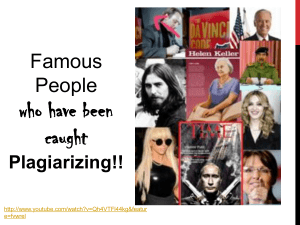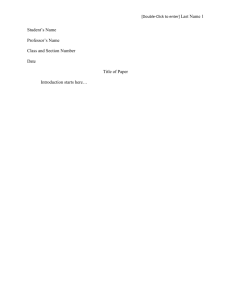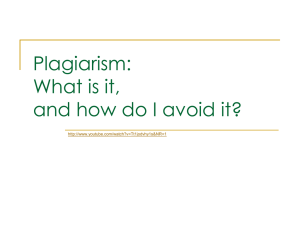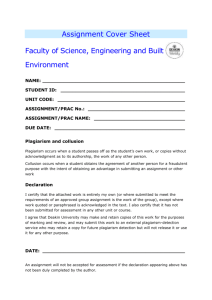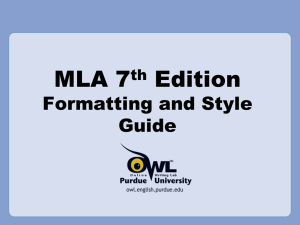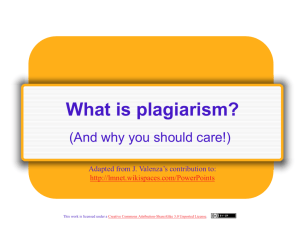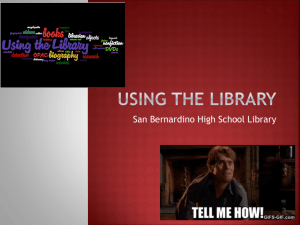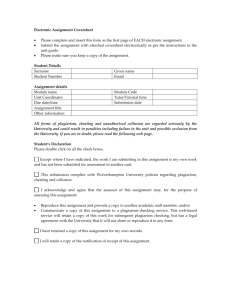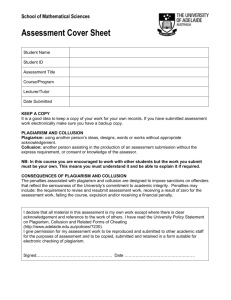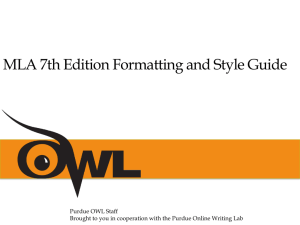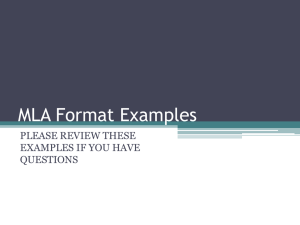Citations - My Teacher Pages
advertisement
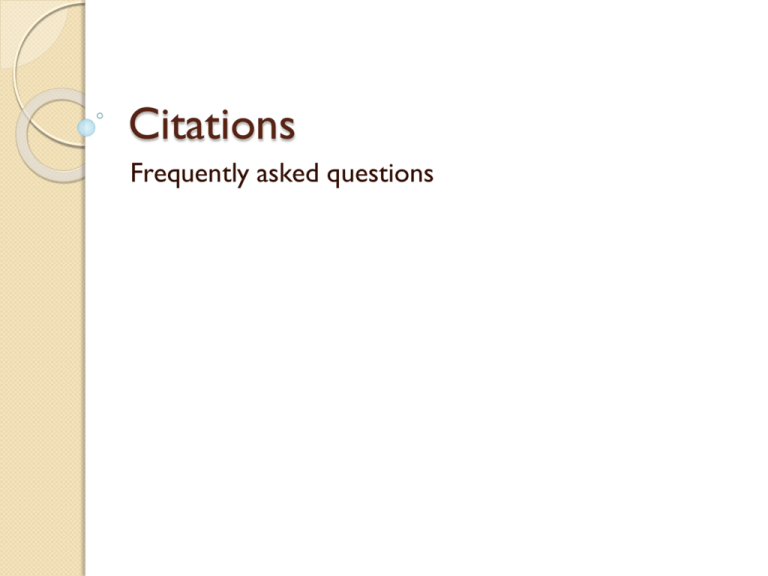
Citations Frequently asked questions Q: Is it still plagiarism if I didn’t intentionally copy someone else’s work and present it as my own, that is, if I plagiarized it by accident? A:Yes, it is still plagiarism. Leaving out the quotation marks around someone else’s words or omitting the attribution after a summary of someone else’s theory may be just a mistake=but faculty can only judge what you turn in to them, not what you intended. Q: If I include a list of works consulted at the end of my paper, doesn’t that cover it? A: No. A works cited list (bibliography) tells your readers what you read but leaves them in the dark about how and where this material has been used in your paper. Putting one or more references at the end of a paragraph containing source material is a version of the same problem. The solution is to cite the source at the point that you quote or paraphrase or summarize it. To be even clearer about what comes from where, also use what are called in-text attributions. Q: Are there some kinds of information that I do not need to document? A: Yes—common knowledge and facts you can find in almost any encyclopedia or basic reference text generally don’t need to be documented (e.g., John F. Kennedy became President of the U.S. in 1960). This distinction can get a little tricky because it isn’t always obvious what is and is not common knowledge. Often you need to spend some time in a discipline before you discover what others take to be known to all. When in doubt, cite the source. Q: If I put the information from my sources into my own words, do I still need to include citations? A:Yes, rewording someone else’s idea doesn’t make it your idea. Paraphrasing is a useful activity because it helps you to better understand what you are reading, but paraphrases and summaries have to be documented and carefully distinguished from ideas and information you are representing as your own. Q: If I don’t actually know anything about the subject, is it okay to hand in a paper that is taken entirely from various sources? A: It’s okay if (1) you document the borrowings, and (2) the assignment called for summary. Properly documented summarizing is better than plagiarizing, but most assignments call for something more. Often comparing and contrasting your sources will begin to give you ideas, so that you can have something to contribute. Q: Is it plagiarism if I include things in my paper that I thought of with another student or a member of my family? A: The Academic Behavior Code, under the category called “collusion,” allows for students’ cooperative efforts only with the explicit consent of the instructor. The same general rule goes for plagiarizing yourself— that is, for submitting the same paper in more than one class. If you have questions about what constitutes collusion in a particular class, be sure to ask your professor. Works Cited Cole, Sally, and Elizabeth Kiss. “What Can We Do About Student Cheating?” About Campus. MayJune 2000: 5-12. Gibaldi, Joseph. MLA Handbook for Writers of Research Papers, 5th Ed. New York: MLA, 1999. Hult, Christine A. Researching and Writing Across the Curriculum. Boston: Allyn and Bacon, 1996. Muhlenberg College Student Handbook, 2000-2001. Rosenwasser, David, and Jill Stephen. Writing Analytically, 2nd ed. Ft. Worth: Harcourt, 2000. In-text citation Wordsworth stated that Romantic poetry was marked by a "spontaneous overflow of powerful feelings" (263). Romantic poetry is characterized by the "spontaneous overflow of powerful feelings" (Wordsworth 263). Wordsworth extensively explored the role of emotion in the creative process (263). Indirect Sources Sometimes you may have to use an indirect source. An indirect source is a source cited in another source. For such indirect quotations, use "qtd. in" to indicate the source you actually consulted. For example: Ravitch argues that high schools are pressured to act as "social service centers, and they don't do that well" (qtd. in Weisman 259). Citing with no known author When a source has no known author, use a shortened title of the work instead of an author name. Place the title in quotation marks if it's a short work (such as an article) or italicize it if it's a longer work (e.g. plays, books, television shows, entire Web sites) and provide a page number. We see so many global warming hotspots in North America likely because this region has "more readily accessible climatic data and more comprehensive programs to monitor and study environmental change . . ." ("Impact of Global Warming" 6). Personal Interview Personal interviews refer to those interviews that you conduct yourself. Purdue, Pete. Personal interview. 1 Dec. 2000. Speeches or Lectures Stein, Bob. "Computers and Writing Conference Presentation." Purdue University. Union Club Hotel, West Lafayette, IN. 23 May 2003. Keynote Address. Work of Art Goya, Francisco. The Family of Charles IV. 1800. Museo del Prado, Madrid. Movies The Usual Suspects. Dir. Bryan Singer. Perf. Kevin Spacey, Gabriel Byrne, Chazz Palminteri, Stephen Baldwin, and Benecio del Toro. Polygram, 1995. Film. TV Episode "The One Where Chandler Can't Cry." Friends:The Complete Sixth Season. Writ. Andrew Reich and Ted Cohen. Dir. Kevin Bright. Warner Brothers, 2004. DVD. Digital Files Beethoven, Ludwig van. Moonlight Sonata. Crownstar, 2006. MP3. Smith, George. “Pax Americana: Strife in a Time of Peace.” 2005. Microsoft Word file. Bentley, Phyllis. “Yorkshire and the Novelist.” The Kenyon Review 30.4 (1968): 509-22. JSTOR. PDF file. Social Media http://guides.ucf.edu/content.php?pid=543 98&sid=399078
